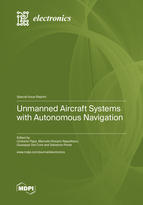Unmanned Aircraft Systems with Autonomous Navigation
A special issue of Electronics (ISSN 2079-9292). This special issue belongs to the section "Systems & Control Engineering".
Deadline for manuscript submissions: closed (30 November 2022) | Viewed by 26973
Special Issue Editors
Interests: unmanned aircraft systems; flight mechanics and dynamics; sensor fusion; structural loads; structure analysis; air navigation
Special Issues, Collections and Topics in MDPI journals
Interests: flight testing; flight controls; flight mechanics; application of neural networks to flight controls
Interests: flight mechanics and dynamics of manned and unmanned aircraft
Special Issues, Collections and Topics in MDPI journals
Interests: UAV/UAS; avionics and navigation systems; flight control; remote sensing; data analysis and processing; control systems; sensors and sensor fusion
Special Issues, Collections and Topics in MDPI journals
Special Issue Information
Dear Colleagues,
Unmanned aerial systems play an increasingly remarkable role in widely diffused application fields, from military defense programs and strategies to civil and commercial utilization. UAS are usually involved in dull, dirty and dangerous (DDD) scenarios, which require reliable, extended-capability, easy-to-use and cost-effective fixed-wing or rotary-wing platforms. Therefore, it is important to provide onboard systems capable of recognizing the environment around the aerial vehicle, detecting and avoiding obstacles, implementing path planning and management strategies, defining safe landing areas, and achieving full autonomy, especially for BVLOS (beyond visual line-of-sight) missions. The technical and economic challenges implied by the issues related to autonomous navigation range from hardware (sensors, platforms, controllers, etc.) to software (data processing and filtering techniques, optimal control, state estimation, innovative algorithms, etc.), and from modeling to practical realizations.
The aim of this Special Issue is to seek high-quality contributions that highlight novel research results and emerging applications, addressing recent breakthroughs in UAS autonomous navigation and related fields, such as flight mechanics and control, structural design, sensor design, etc.
The topics of interest include the following:
- 2D and 3D mapping, target detection and obstacle avoidance;
- The active perception of targets in cluttered environments (foliage, forests, etc.);
- Vision-based and optical flow techniques;
- Sensors and sensor fusion techniques;
- Design models for guidance and controlled flight;
- State estimation, data analysis and filtering techniques (KF, EKF, particle filtering, fuzzy logic, etc.);
- Path planning and path management;
- Optimal control and strategies (neural networks, fuzzy logic, reinforcement learning, evolutionary and genetic algorithms, AI, etc.);
- Navigation in GPS-denied environments;
- Autolanding and safe landing area definition (SLAD);
- Environmental effects on UAVs (wind, etc.);
- Autonomous UAV or MAV swarms, and distributed architectures;
- BVLOS autonomous navigation.
Technical Program Committee Members:
MSc Gennaro Ariante, Department of Science and Technology, University of Naples Parthenope Naples, Italy.
Mr. Alberto Greco, Department of Science and Technology, University of Naples Parthenope Naples, Italy.
Dr. Umberto Papa
Prof. Marcello Rosario Napolitano
Prof. Giuseppe Del Core
Prof. Salvatore Ponte
Guest Editors
Manuscript Submission Information
Manuscripts should be submitted online at www.mdpi.com by registering and logging in to this website. Once you are registered, click here to go to the submission form. Manuscripts can be submitted until the deadline. All submissions that pass pre-check are peer-reviewed. Accepted papers will be published continuously in the journal (as soon as accepted) and will be listed together on the special issue website. Research articles, review articles as well as short communications are invited. For planned papers, a title and short abstract (about 100 words) can be sent to the Editorial Office for announcement on this website.
Submitted manuscripts should not have been published previously, nor be under consideration for publication elsewhere (except conference proceedings papers). All manuscripts are thoroughly refereed through a single-blind peer-review process. A guide for authors and other relevant information for submission of manuscripts is available on the Instructions for Authors page. Electronics is an international peer-reviewed open access semimonthly journal published by MDPI.
Please visit the Instructions for Authors page before submitting a manuscript. The Article Processing Charge (APC) for publication in this open access journal is 2400 CHF (Swiss Francs). Submitted papers should be well formatted and use good English. Authors may use MDPI's English editing service prior to publication or during author revisions.
Keywords
- Unmanned aircraft systems
- Autonomous navigation
- Flight mechanics and dynamics
- Sensor fusion
- Filtering techniques
- Optimization algorithms
- State estimation







